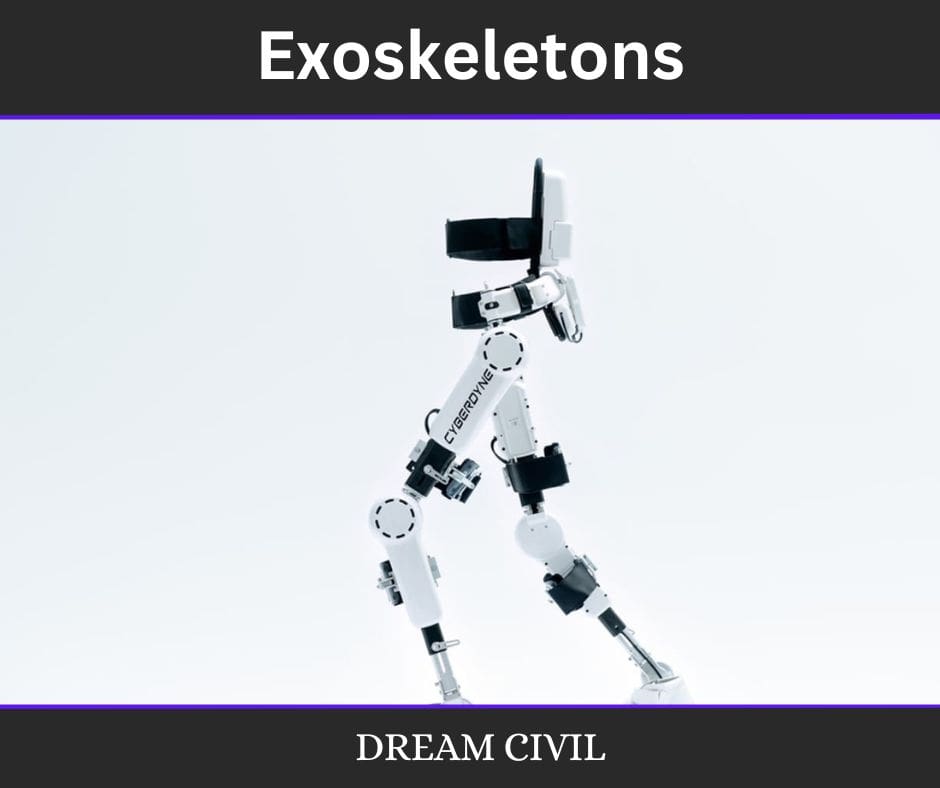Table of Contents
The adoption of new technologies in the construction field is increasing rapidly to improve the safety and productivity of workers. Among such new trend technologies; Exoskeletons are one.
Exoskeletons are wearable electromechanical devices suited with motorized joints that are placed on the user’s body and act as enhancers that augment human performance.
They aim to minimize strain and injury by providing posture correction, weight dispersion, lift support, etc.
Commonly, frames of exoskeletons are prepared with hard materials (like lightweight metals). To improve safety and comfort; soft materials like cloths and textiles are also utilized.
Based on the type, exoskeletons may be operated manually or with electricity, or with both.
Spring systems, hydraulics systems, sensing systems, motor systems, etc are commonly used in these devices to enhance the human ability to work.
2. What is the History of Exoskeletons?
Different manually working exoskeletons were developed between the 18th and 19th centuries.
The development of modern types of exoskeletons began in the 1960s with the development of a suite called Hardiman which was co-developed by General Electric and the US Armed Forces.
Exoskeletons were developed initially for military purposes to improve the safety, productivity, and capabilities of soldiers. Such exoskeletons were featured with advanced weapons and technologies of that time.
With the passing of time and modifications, this technology is now adopted in the construction sector.
China, the USA, Japan & Israel are the top users of exoskeletons in the field of construction ( In 2021).
3. What are the Aims of Exoskeletons?
Some aims of this device are:
a. To reduce the injuries to the workers by minimizing the strain.
b. To improve the productivity of workers by providing lift support, posture correction, etc.
c. To reduce workmanship/labor cost in the project by improving the speed and efficiency of labor.
4. What are the Types of Exoskeletons?
Exoskeletons can be classified into two types based on operation and the area of the body they support.
a. Based on Operation
There are 3 types of exoskeletons based on the operation. Depending upon the manufacturer, exoskeletons can be operated either mechanically or with electricity, or with both.
i. Mechanical Exoskeletons
These devices are operated mechanically and contain no motor or sensing systems so they are cheaper but more tedious than electrically operated ones.
Some features are:
~ No need for power or electricity.
~ Users enjoy longevity in the field since there is no requirement of recharging or carrying of power source.
~ They commonly work on hydraulic and spring systems.
~ Operating skill is required.

ii. Electrical Exoskeletons
They are more powerful and can handle more weight as compared to mechanical exoskeletons.
They can target more specific areas, like the hand, and increase pressure and strength where needed.
Some cons of electrical exoskeletons are:
a. Requirement of power or charge to operate.
b. Batteries and power-supplying devices add extra weight.
c. No longevity in the field since there is a requirement for recharging.

iii. Hybrid Exoskeletons
These exoskeletons have features of both mechanical as well as electrical exoskeletons.
They are more expensive than other types of exoskeletons but offer more flexibility in the work as they can be operated manually or electrically.
They are suitable for both short and long time types of work.

b. Based on the Area of the Body They Support
Some exoskeletons based on the area of the body they support are:
i. Power Gloves
Power gloves support workers during grip-intensive and repetitive tasks. Generally, these gloves are electrically operatable and contain sensors that detect when the user is about to grip an object and increase power based on the object’s weight.
These gloves mainly improve the safety of workers and save more energy by the end of the workday.

ii. Arm and Shoulder Exoskeleton
Arm and shoulder support is generally useful for overhead activities and also for lifting heavy materials above the waist. It supports shoulders and arms to reduce the strain of regularly supporting heavy tools for a long period of time.
They are lightweight, low profile, and do not hamper movability.

iii. Back Support
Back support is very useful in stopping, lifting, and reaching. They also help the worker to correct their posture when bending or lifting depending on the manufacturer’s product.
Back support fits around your shoulders, back, and waist to decrease stress on the back while lifting heavy objects and reduce back pressure.
iv. Standing and Crouching
Standing and crouching are generally useful for work that needs continuous standing. For example when you are drilling for a long time.
The advantage of this suit is that it decreases pressure on knees and legs and transfers weight down to the ground. This decreases strain on joints and muscles when in a standing or crouching position for a long period of time.
It also provides the facility to “sit” for workers when there are no chairs available or would otherwise hamper safety or productivity in the work zone. It is useful for construction workers who stand for a long period during the workday.

v. Whole-Body Suits
Whole-Body Suits are very useful for workers who carry or lift heavy objects during the workday. Whole-body suits give support throughout the whole body to minimize strain, maximize productivity, and increase strength.
It can be found in both mechanical and electrical, both coming with their own sets of advantages and disadvantages.

5. Advantages of Exoskeletons
1. It helps to increase productivity.
2. It reduces the chance of injuries and strain.
3. It makes it easy to carry and lift the load.
4. It allows complex movements
5. Protect workers from hazardous conditions.
6. Disadvantages of Exoskeletons
1. It is very costly.
2. It limits your movement.
3. It is very heavy and bulky in size.
7. Cost of Exoskeletons
As already mentioned in the disadvantages, it is very costly to buy. The cost can vary from $2000 to $45,000, which is a lot so many people cannot provide them.
Read Also: Concrete Cutting Machine

